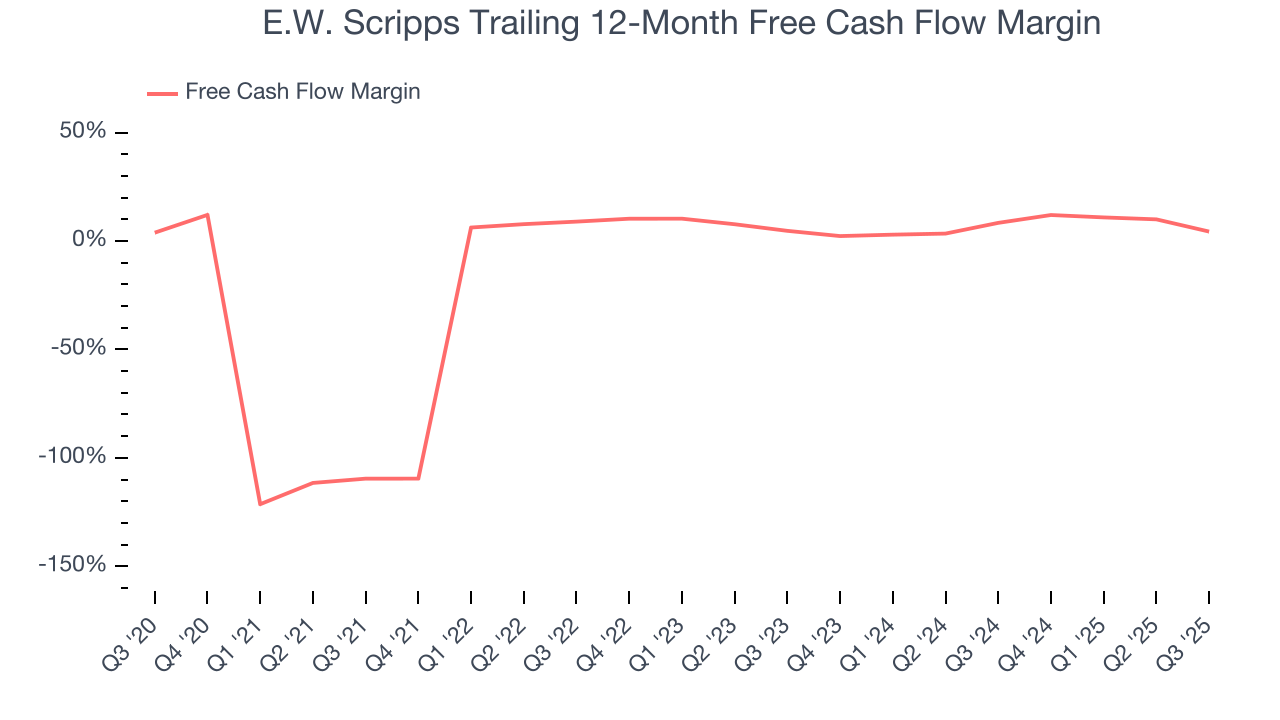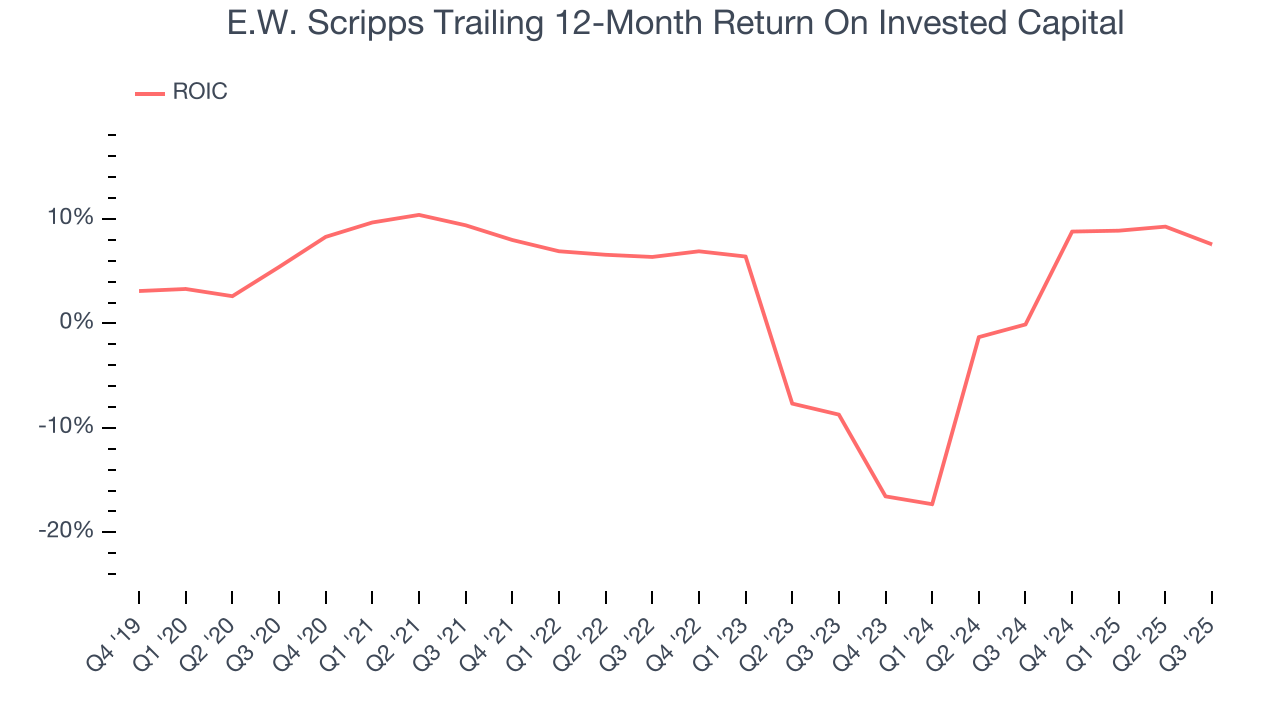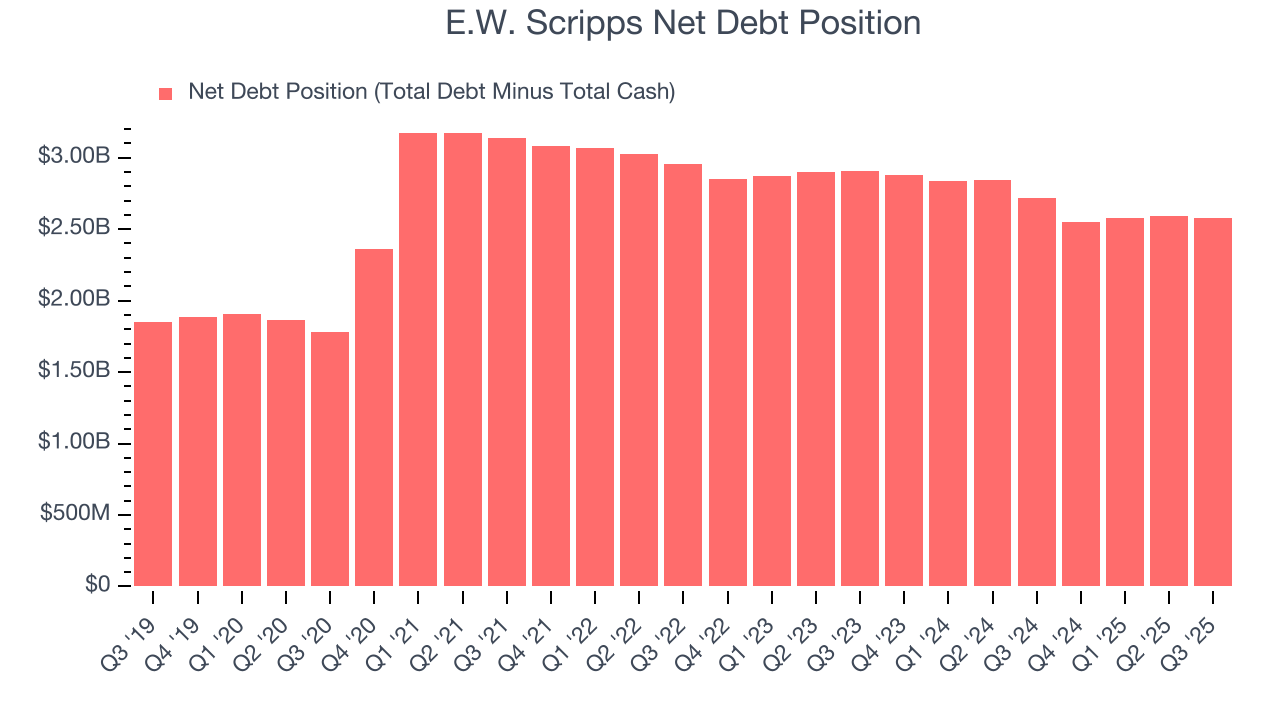
E.W. Scripps (SSP)
E.W. Scripps is up against the odds. Its sales have underperformed and its low returns on capital show it has few growth opportunities.― StockStory Analyst Team
1. News
2. Summary
Why We Think E.W. Scripps Will Underperform
Founded as a chain of daily newspapers, E.W. Scripps (NASDAQ:SSP) is a diversified media enterprise operating a range of local television stations, national networks, and digital media platforms.
- Muted 6.5% annual revenue growth over the last five years shows its demand lagged behind its consumer discretionary peers
- Incremental sales over the last five years were much less profitable as its earnings per share fell by 24.6% annually while its revenue grew
- High net-debt-to-EBITDA ratio of 5× increases the risk of forced asset sales or dilutive financing if operational performance weakens


E.W. Scripps falls short of our quality standards. There are superior stocks for sale in the market.
Why There Are Better Opportunities Than E.W. Scripps
High Quality
Investable
Underperform
Why There Are Better Opportunities Than E.W. Scripps
E.W. Scripps is trading at $4.53 per share, or 1x forward EV-to-EBITDA. The current valuation may be fair, but we’re still passing on this stock due to better alternatives out there.
We’d rather pay up for companies with elite fundamentals than get a decent price on a poor one. High-quality businesses often have more durable earnings power, helping us sleep well at night.
3. E.W. Scripps (SSP) Research Report: Q3 CY2025 Update
Media, broadcasting, and digital services company E.W. Scripps (NASDAQ:SSP) met Wall Streets revenue expectations in Q3 CY2025, but sales fell by 18.6% year on year to $525.9 million. Its GAAP loss of $0.55 per share was 70.8% below analysts’ consensus estimates.
E.W. Scripps (SSP) Q3 CY2025 Highlights:
- Revenue: $525.9 million vs analyst estimates of $523.9 million (18.6% year-on-year decline, in line)
- EPS (GAAP): -$0.55 vs analyst expectations of -$0.32 (70.8% miss)
- Adjusted EBITDA: $80.43 million vs analyst estimates of $68.75 million (15.3% margin, 17% beat)
- Operating Margin: 7.2%, down from 18.8% in the same quarter last year
- Free Cash Flow was -$15.07 million, down from $127.4 million in the same quarter last year
- Market Capitalization: $185.1 million
Company Overview
Founded as a chain of daily newspapers, E.W. Scripps (NASDAQ:SSP) is a diversified media enterprise operating a range of local television stations, national networks, and digital media platforms.
Edward Willis Scripps established the company in 1878 to provide accessible news to the public. Over the years, Scripps expanded from its newspaper roots into broadcasting and digital media, reflecting the evolving preferences of consumers.
E.W. Scripps manages numerous local TV stations and national networks, offering news, information, and entertainment. It has also ventured into the digital domain with various online platforms, catering to the contemporary demand for multi-platform media access. This expansion into digital media complements Scripps’ traditional broadcasting operations, addressing the diverse preferences of modern audiences.
The company's revenue sources include advertising, retransmission fees, and subscriptions.
4. Broadcasting
Broadcasting companies have been facing secular headwinds in the form of consumers abandoning traditional television and radio in favor of streaming services. As a result, many broadcasting companies have evolved by forming distribution agreements with major streaming platforms so they can get in on part of the action, but will these subscription revenues be as high quality and high margin as their legacy revenues? Only time will tell which of these broadcasters will survive the sea changes of technological advancement and fragmenting consumer attention.
Competitors in the local television broadcasting and digital media sector include Nexstar Media (NASDAQ:NXST), Sinclair (NASDAQ:SBGI), and TEGNA (NYSE:TGNA).
5. Revenue Growth
A company’s long-term sales performance is one signal of its overall quality. Any business can have short-term success, but a top-tier one grows for years. Unfortunately, E.W. Scripps’s 6.5% annualized revenue growth over the last five years was sluggish. This fell short of our benchmark for the consumer discretionary sector and is a poor baseline for our analysis.

Long-term growth is the most important, but within consumer discretionary, product cycles are short and revenue can be hit-driven due to rapidly changing trends and consumer preferences. E.W. Scripps’s recent performance shows its demand has slowed as its revenue was flat over the last two years. 
This quarter, E.W. Scripps reported a rather uninspiring 18.6% year-on-year revenue decline to $525.9 million of revenue, in line with Wall Street’s estimates.
Looking ahead, sell-side analysts expect revenue to decline by 1.5% over the next 12 months, similar to its two-year rate. This projection doesn't excite us and suggests its newer products and services will not accelerate its top-line performance yet.
6. Operating Margin
E.W. Scripps’s operating margin has been trending up over the last 12 months and averaged 7.5% over the last two years. The company’s higher efficiency is a breath of fresh air, but its suboptimal cost structure means it still sports paltry profitability for a consumer discretionary business.

This quarter, E.W. Scripps generated an operating margin profit margin of 7.2%, down 11.7 percentage points year on year. This contraction shows it was less efficient because its expenses increased relative to its revenue.
7. Earnings Per Share
Revenue trends explain a company’s historical growth, but the long-term change in earnings per share (EPS) points to the profitability of that growth – for example, a company could inflate its sales through excessive spending on advertising and promotions.
Sadly for E.W. Scripps, its EPS declined by 24.5% annually over the last five years while its revenue grew by 6.5%. This tells us the company became less profitable on a per-share basis as it expanded.

In Q3, E.W. Scripps reported EPS of negative $0.55, down from $0.38 in the same quarter last year. This print missed analysts’ estimates. Over the next 12 months, Wall Street expects E.W. Scripps to perform poorly. Analysts forecast its full-year EPS of negative $0.43 will tumble to negative $0.50.
8. Cash Is King
Free cash flow isn't a prominently featured metric in company financials and earnings releases, but we think it's telling because it accounts for all operating and capital expenses, making it tough to manipulate. Cash is king.
E.W. Scripps has shown weak cash profitability over the last two years, giving the company limited opportunities to return capital to shareholders. Its free cash flow margin averaged 6.4%, subpar for a consumer discretionary business.

E.W. Scripps burned through $15.07 million of cash in Q3, equivalent to a negative 2.9% margin. The company’s cash flow turned negative after being positive in the same quarter last year, prompting us to pay closer attention. Short-term fluctuations typically aren’t a big deal because investment needs can be seasonal, but we’ll be watching to see if the trend extrapolates into future quarters.
9. Return on Invested Capital (ROIC)
EPS and free cash flow tell us whether a company was profitable while growing its revenue. But was it capital-efficient? Enter ROIC, a metric showing how much operating profit a company generates relative to the money it has raised (debt and equity).
E.W. Scripps historically did a mediocre job investing in profitable growth initiatives. Its five-year average ROIC was 2.9%, lower than the typical cost of capital (how much it costs to raise money) for consumer discretionary companies.

We like to invest in businesses with high returns, but the trend in a company’s ROIC is what often surprises the market and moves the stock price. On average, E.W. Scripps’s ROIC decreased by 4.1 percentage points annually over the last few years. Paired with its already low returns, these declines suggest its profitable growth opportunities are few and far between.
10. Balance Sheet Risk
Debt is a tool that can boost company returns but presents risks if used irresponsibly. As long-term investors, we aim to avoid companies taking excessive advantage of this instrument because it could lead to insolvency.
E.W. Scripps’s $2.65 billion of debt exceeds the $69.97 million of cash on its balance sheet. Furthermore, its 5× net-debt-to-EBITDA ratio (based on its EBITDA of $474.2 million over the last 12 months) shows the company is overleveraged.

At this level of debt, incremental borrowing becomes increasingly expensive and credit agencies could downgrade the company’s rating if profitability falls. E.W. Scripps could also be backed into a corner if the market turns unexpectedly – a situation we seek to avoid as investors in high-quality companies.
We hope E.W. Scripps can improve its balance sheet and remain cautious until it increases its profitability or pays down its debt.
11. Key Takeaways from E.W. Scripps’s Q3 Results
We enjoyed seeing E.W. Scripps beat analysts’ EBITDA expectations this quarter. On the other hand, its EPS missed. Overall, this was a mixed quarter. The stock remained flat at $2.04 immediately after reporting.
12. Is Now The Time To Buy E.W. Scripps?
Updated: December 4, 2025 at 9:54 PM EST
Are you wondering whether to buy E.W. Scripps or pass? We urge investors to not only consider the latest earnings results but also longer-term business quality and valuation as well.
We cheer for all companies serving everyday consumers, but in the case of E.W. Scripps, we’ll be cheering from the sidelines. To kick things off, its revenue growth was weak over the last five years, and analysts expect its demand to deteriorate over the next 12 months. On top of that, E.W. Scripps’s Forecasted free cash flow margin for next year suggests the company will fail to improve its cash conversion, and its declining EPS over the last five years makes it a less attractive asset to the public markets.
E.W. Scripps’s EV-to-EBITDA ratio based on the next 12 months is 1.1x. While this valuation is reasonable, we don’t see a big opportunity at the moment. There are more exciting stocks to buy at the moment.
Wall Street analysts have a consensus one-year price target of $5.63 on the company (compared to the current share price of $4.39).
Although the price target is bullish, readers should exercise caution because analysts tend to be overly optimistic. The firms they work for, often big banks, have relationships with companies that extend into fundraising, M&A advisory, and other rewarding business lines. As a result, they typically hesitate to say bad things for fear they will lose out. We at StockStory do not suffer from such conflicts of interest, so we’ll always tell it like it is.









